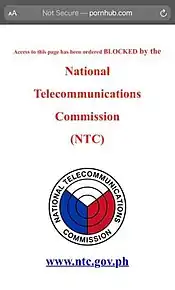Censorship in the Philippines
Censorship in the Philippines refers to the control of certain information in the Philippines.
History
Spanish colonial period
There was government-sanctioned censorship in the Philippines as a Spanish colony which was perceived to be prevalent. However the level of censorship varied depending on the sitting Governor General.[1]:396 Noted publications banned by the colonial authorities were the Noli Me Tángere and El filibusterismo novels of José Rizal which were critical of the Spanish colonial government and the church.
From 1857 to 1883, the Spanish largely regulated the press in the Philippines through the Rules of Printing Matters (Reglamento de Asuntos de Imprenta) under which newspapers were required to obtain a license from the government. This was followed by the Printing Order or Gullón (De policía de imprenta o Gullón) in 1883 by the Liberal Spanish government at the time which led to the emergence of multiple Philippines newspapers until the end of the Spanish colonial period.[1]:396, 398–401
American colonial period
The United States administration introduced laws against sedition and libel in the Philippines in 1901 through the Sedition Act and the Criminal Libel Act. This has led to the closure of El Renacimiento which openly advocated for Philippine independence, advocated the usage of Spanish as an official language, and was critical of Governor General William Howard Taft's policies in 1908.[1]:397
The Board of Censorship for Moving Pictures (BCMP) was formed in November 27, 1929 through Commonwealth Act No. 3852. By 1930, the first board of the BCMP reviewed 1,249 films for public exhibition, six of which was allowed only with cuts, and two were banned. The BCMP became the Board of Review for Moving Pictures (BRMP) in 1936.[2]
World War II
During the Japanese occupation of the Philippines during World War II, the Japanese banned all publications not for the Japanese audience save for Manila Tribune, Taliba, and La Vanguardia. Publications by these local newspapers were heavily censured by the Japanese Imperial Army. However underground publications were accessible to Filipinos during this period which allowed the distribution of information not censured by the Japanese.[3]
Post-Commonwealth period
The Board of Review for Moving Pictures (BRMP) was reorganized as the Board of Censors of Motion Pictures (BCMP) during the earlier years of the administration of President Ferdinand Marcos in June 17, 1961. The BCMP was constituted through Republic Act No. 3060, and was placed under the Office of the President.[2]
Martial Law period
As part of the imposition of Martial Law during the administration of President Ferdinand Marcos in 1972 until the 1980s, the press was heavily regulated and censored. All publications including from foreign news outfits had to be approved by the Department of Public Information. Society news, editorial commentary, and content critical to the Philippine government were among those banned.[4] The government seized control of privately-owned media. Only Daily Express and Bulletin Today (Manila Bulletin) were allowed to resume operations among those publications which existed prior to Martial Law.[3]
The regulations encouraged self-censorship by the press which were traditionally adversarial towards the government although an "alternative press" unsanctioned by the government emerged in the 1980s. Among these publications which form part of the alternative press are Jose Burgos' WE Forum and Pahayagang Malaya, Felix Bautista and Melinda de Jesus edited Veritas; Raul and Leticia Locsin's Business Day (present-day Business World); Eugenia Apostol and Leticia Magsanoc's Inquirer and Mr. and Ms. Magazine. The phenomenon of samizdat or xerox journalism also proliferated which involved the dissemination of news clippings, usually from publications abroad, which were not checked by the government's censors. These were often proliferated by Filipino journalists working for foreign news outfits.[3]
President Marcos reorganized the Board of Censors of Motion Pictures as the Board of Review for Motion Pictures and Television (BRMPT) on November 13, 1981 through Executive Order No. 745. The Movie and Television Review and Classification Board (MTRCB) was created October 5, 1985, replacing the BRMPT[2] through Presidential Decree No. 1986. It was tasked to regulate and classify media including motion picture and television programs.[5]
Cotemporary period (1986–present)
With the advent of the internet in the Philippines, there was debate regarding the necessity of censorship in the 1990s to block cyber pornography in response to reports of Filipinos being prostituted through online means. The issue reached the Senate at the time with Senators Blas Ople and Orlando Mercado calling for a hearing on the matter in 1995, and Senator Gregorio Honasan filing a bill as a bid to address the matter.[6]
In 2000, the Roman Catholic Church in the Philippines through the Catholic Bishops' Conference of the Philippines (CBCP) launched cbcpNet, its own internet service provider (ISP) which filters out content depicting pornography, homosexuality, violence and devil worship, for its subscribers. This venture failed due to CBCP's partners fleding the Philippines which led to debt and legal issues. CBCP World, was introduced in 2002, the CBCP's second attempt to setup its own ISP which also offered filtered online access like its predecessor.[7][8][9]
The passing of the Cybercrime Prevention Act in 2012, was a subject of concern by human rights activists especially its provisions on cyberlibel.[10][11]The law was challenged and the Supreme Court ruled in 2014 that the original author of libelous content is only liable against the law saying that the act of posting libelous content is not a crime. The court also iterated that access to websites can't be restricted by the Department of Justice without a prior court order and that the government could not monitor individuals in "real time" without the same.[10]
In September 2020, the MTRCB proposed the regulation of content distributed through online streaming services including Netflix believing that these content falls under their mandate to regulate and classify "all forms" of motion picture. Such plans raised concerns over censorship.[12]
By medium
Television and film
The Movie and Television Review and Classification Board is responsible for rating television programs, movies and home videos aired in the Philippines. The government agency can classify a movie or television program an X rating, effectively banning the work from public screening. The MTRCB is however criticized for its views on what constitutes obscenity, and is also accused of giving the X rating to materials for political reasons such as Ora Pro Nobis by Lino Brocka, which gained controversy for its allegations of continued human rights violations in the Philippines after the 1986 EDSA revolution.[13]
Internet

The Freedom on the Net 2013 by the Freedom House ranked the Philippines 10th out of 60 countries. It said that it did not receive reports that officials are pressuring bloggers or online journalists to delete content deemed critical to the authorities. However it said that "many news websites are online versions of traditional media which self-censor due to the level of violence against journalists in the Philippines".[14]
It also said that "The government does not require the registration of user information prior to logging online or subscribing to internet and mobile phone services, especially since prepaid services are widely available, even in small neighborhood stores." The same report also stated that the Cybercrime Prevention Act of 2012 negatively affected the state of internet freedom of the country. It has also noted that the internet penetration of the country remains low which it attributes to PLDT's "de facto monopoly" and lack of infrastructure and bureaucratic government regulation. The study says that the monopoly resulted to high broadband subscription fees.[14]
A study released in March 2014 by United States-based, Pew Research Center states that most Filipinos find access to the internet without censorship is important or somewhat important. 35% of the respondents said they found internet access without censorship as "very important", 38% as "somewhat important", 18% "not too important", 6% "not important" and the rest said they don't know or refused to answer.[15]
See also
References
- Cano, Glòria (December 2011). "Filipino Press between Two Empires: El Renacimiento, a Newspaper with Too Much Alma Filipina" (PDF). Southeast Asian Studies. 49 (3).
- Yuson, Alfred A. (October 11, 2020). "MTRCB turns 30". The Philippine Star. Retrieved November 17, 2020.
- Tuazon, Ramon. "The Print Media: A Tradition of Freedom". National Commission for Culture and the Arts. Retrieved November 7, 2020.
- "Manila Imposes Strict Censorship on News Media (Published 1972)". The New York Times. September 29, 1972. Retrieved November 7, 2020.
- "Did You Know: MTRCB was created on Oct. 5, 1985". Philippine Daily Inquirer. Inquirer Research. October 5, 2018. Retrieved November 7, 2020.
- Paraz, Miguel. "Developing a Viable Framework for Commercial Internet Operations in the Asia-Pacific Region: The Philippine Experience". Internet Society. IPhil Communications. Archived from the original on January 3, 2016. Retrieved November 9, 2020.
- McFarland, Sofia (March 18, 2000). "For Filipinos Lacking Internet Access, Catholic Church Promises Salvation". Wall Street Journal. Retrieved November 9, 2020.
- Araneta, Sandy (January 25, 2000). "Church offers access to `wholesome' Internet". The Philippine Star. Retrieved November 9, 2020.
- "Founders Of Catholic Internet Provider Deny Mismanagement Charges". UCA News. March 10, 2008. Retrieved November 9, 2020.
- York, Jillian; Carlson, Kimberly (April 3, 2014). "Philippines: Inching Toward Censorship". Electronic Frontier Foundation. Retrieved November 9, 2020.
- "Philippine cybercrime law takes effect amid protests". BBC News. October 3, 2012. Retrieved November 9, 2020.
- Mendiola, Ritchel (September 9, 2020). "No plans to censor Netflix in PH – MTRCB —". Asian Journal News. Retrieved November 7, 2020.
- Teodoro, Luis (14 May 2012). "Censorship in disguise". In Medias Res. Retrieved 13 August 2015.
- Malig, Jojo (4 October 2013). "Internet freedom costly for Filipinos, study says". ABS-CBNnews.com. Retrieved 13 August 2015.
- "Should gov't censor Internet access?". MoneyPolitics. Philippine Center for Investigative Journalism. Archived from the original on 9 October 2015. Retrieved 13 August 2015.
